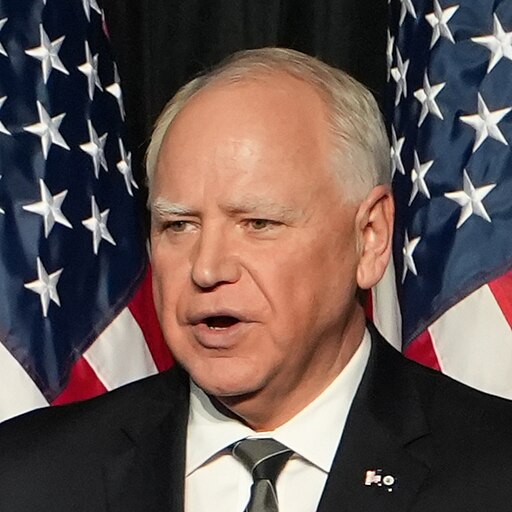Minnesota gov. Tim Walz’s son, Gus, moves the audience with his emotional support during his father’s keynote speech, bringing attention to neurodiversity at the Democratic National Convention
At the Democratic National Convention on August 21, 2024, Gus Walz, the 17-year-old son of Minnesota Governor Tim Walz, captured the hearts of the nation with a heartfelt display of pride and support. As his father delivered a keynote address accepting the vice-presidential nomination, Gus stood in the audience, overwhelmed with emotion. His enthusiastic shout, “That’s my dad!” and the tears that followed drew a standing ovation and brought significant attention to his personal journey and neurodiversity.
Tim Walz, who was making his case for the vice presidency, was momentarily overshadowed by his son’s emotional outburst, which resonated deeply with viewers. In a touching moment of family solidarity, Gus’s display not only highlighted his father’s political moment but also introduced millions to his own story.
Embed from Getty ImagesGus Walz has faced considerable challenges in his life. Diagnosed with nonverbal learning disorder, ADHD, and anxiety as a teenager, his condition has shaped his experiences and interactions. Despite these challenges, his family sees Gus’s condition not as a setback but as a source of unique strengths. In a statement to People magazine, Tim and Gwen Walz described Gus as “brilliant” and “hyper-aware of details that many of us pass by.” They emphasized that his neurodiversity is integral to his identity and that he excels in areas that are often overlooked.
Nonverbal learning disorder (NVLD) is a neurodevelopmental condition that affects an individual’s ability to process visual and spatial information. Those with NVLD often excel in verbal tasks but struggle with activities that require visual-spatial reasoning, such as geometry or understanding nonverbal social cues. Rick Ostrander, a retired child psychologist, notes that NVLD can make it challenging for affected children to visualize and organize information effectively.
ADHD, another condition Gus lives with, is a common neurodevelopmental disorder characterized by difficulties with attention, hyperactivity, and impulsiveness. The condition affects approximately 1 in 9 children in the United States. ADHD can manifest in various forms, including issues with maintaining focus, excessive fidgeting, or a combination of both. Treatment often includes stimulants and behavioral therapy, aimed at helping individuals develop effective coping strategies and organizational skills.
The Walz family’s approach to Gus’s neurodiversity reflects a broader understanding and acceptance of these conditions. They have embraced his differences as strengths, and Gus’s public appearance has sparked conversations about the broader implications of neurodiversity.
Analysis:
Political Perspective: Gus Walz’s appearance at the DNC, especially during such a significant moment for his father, has inadvertently spotlighted neurodiversity on a national stage. The positive media attention and public response contribute to a growing political and societal recognition of neurodiversity issues. This visibility can lead to increased advocacy for policies that support neurodiverse individuals, including improved access to education and healthcare services tailored to their needs. Additionally, the public’s warm reception of Gus underscores a shift toward a more inclusive political environment, where personal stories can influence and enhance political discourse.
Social Perspective: Gus’s emotional display has resonated with many, bringing to light the daily experiences of neurodiverse individuals and their families. By sharing his story in such a high-profile setting, the Walz family has contributed to a more nuanced understanding of neurodiversity. This moment at the DNC aligns with a broader societal trend towards greater acceptance and inclusion of people with different neurological conditions. The heartfelt nature of Gus’s support has humanized these conditions, encouraging empathy and reducing stigma.
Racial Perspective: The story of Gus Walz intersects with broader conversations about racial diversity and inclusion. While Gus’s neurodiversity is the focus here, it is also part of a larger dialogue about how different communities support and understand various neurological conditions. In diverse societies, recognizing and addressing the needs of neurodiverse individuals from all racial and ethnic backgrounds is crucial for fostering equity. The visibility of Gus Walz’s experience can help promote a more inclusive approach to understanding neurodiversity across different racial groups.
Gender Perspective: Gus Walz’s experience also intersects with discussions about gender roles and expectations. Neurodiversity is often framed through the lens of traditional gender expectations, with certain conditions being more commonly diagnosed in one gender over another. By highlighting Gus’s story, there is an opportunity to challenge stereotypes and assumptions about gender and neurodiversity. This exposure can help dismantle gender-based biases and promote a more balanced view of how neurodevelopmental conditions affect individuals regardless of gender.
Economic Perspective: The increased awareness of neurodiversity brought about by Gus Walz’s appearance may have economic implications, particularly in the realms of education and employment. A heightened public and political focus can drive investment in programs that support neurodiverse individuals, such as specialized educational resources and workplace accommodations. Additionally, businesses may recognize the value of diverse cognitive perspectives, leading to more inclusive hiring practices and workplace environments that embrace neurodiverse talents.
